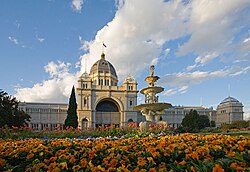Royal Exhibition Building
| Royal Exhibition Building | |
|---|---|

The Royal Exhibition Building, showing the fountain on the southern or Carlton Gardens side of the building
|
|
| General information | |
| Location | 9 Nicholson Street, Melbourne, Australia |
| Coordinates | 37°48′17″S 144°58′16″E / 37.804728°S 144.971225°ECoordinates: 37°48′17″S 144°58′16″E / 37.804728°S 144.971225°E |
| Construction started | 1879 |
| Completed | 1880 |
| Design and construction | |
| Architect | Joseph Reed |
| Official name | Royal Exhibition Building and Carlton Gardens |
| Type | Cultural |
| Criteria | ii |
| Designated | 2004 (28th session) |
| Reference no. | 1131 |
| State Party |
|
| Region | Asia-Pacific |
The Royal Exhibition Building is a World Heritage Site-listed building in Melbourne, Australia, completed in 1880. It is located at 9 Nicholson Street in the Carlton Gardens, flanked by Victoria, Carlton and Rathdowne Streets, at the north-eastern edge of the central business district. It was built to host the Melbourne International Exhibition in 1880–81 and later hosted (in the Western annex) the opening of the first Parliament of Australia in 1901. Throughout the 20th century smaller sections and wings of the building were subject to demolition and fire; however, the main building, known as the Great Hall, survived.
It received restoration throughout the 1990s and in 2004 became the first building in Australia to be awarded UNESCO World Heritage status, being one of the last remaining major 19th-century exhibition buildings in the world. It is the world's most complete surviving site from the International Exhibition movement 1851–1914. It sits adjacent to the Melbourne Museum and is the largest item in Museum Victoria's collection. Today, the building hosts various exhibitions and other events and is closely tied with events at the Melbourne Museum.
The Royal Exhibition Building was designed by the architect Joseph Reed, who also designed the Melbourne Town Hall and the State Library of Victoria. According to Reed, the eclectic design was inspired by many sources. The dome was modeled on the Florence Cathedral, while the main pavilions were influenced by the style of Rundbogenstil and several buildings from Normandy, Caen and Paris.
...
Wikipedia
